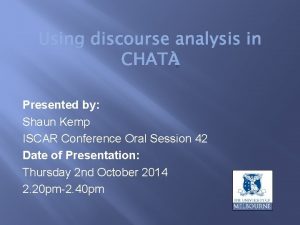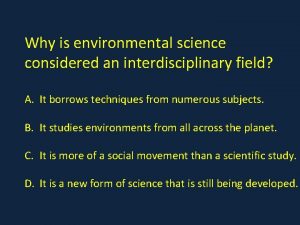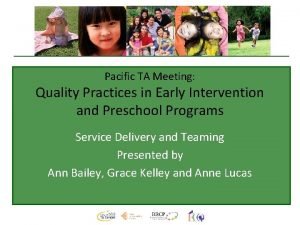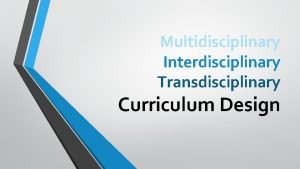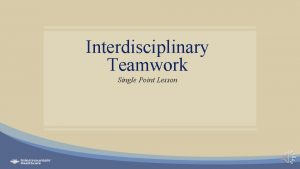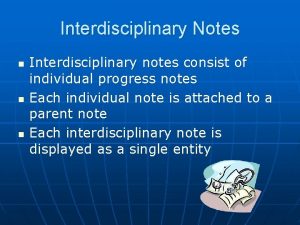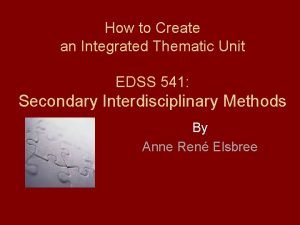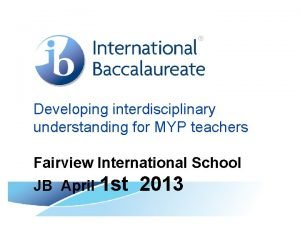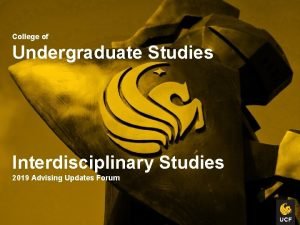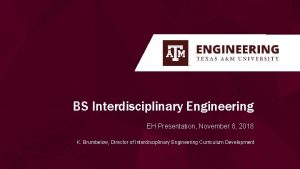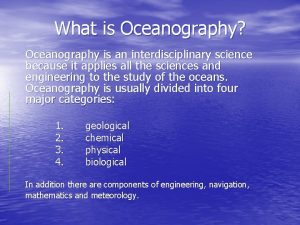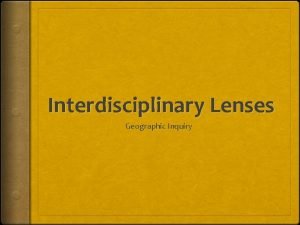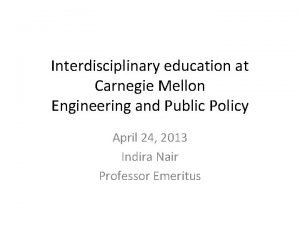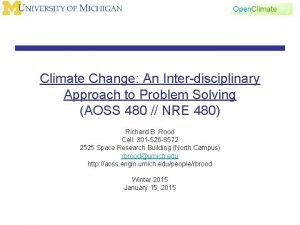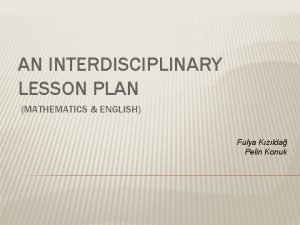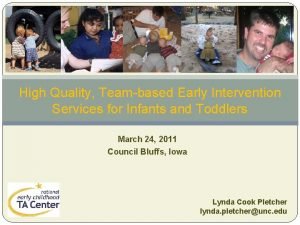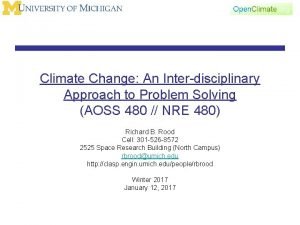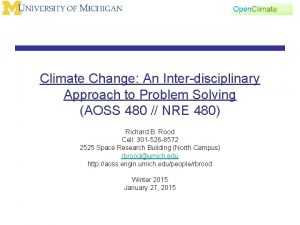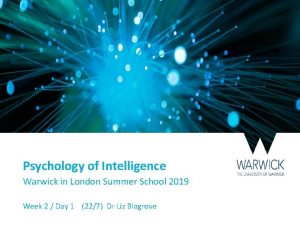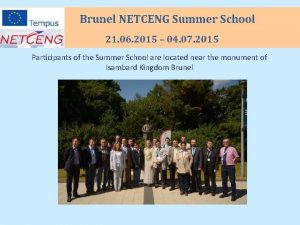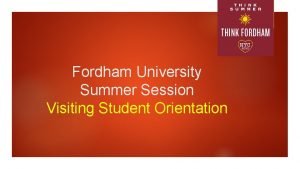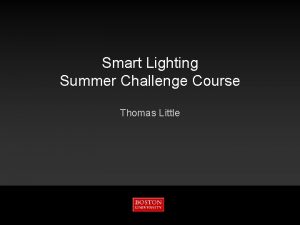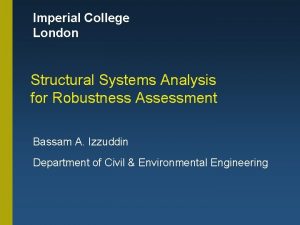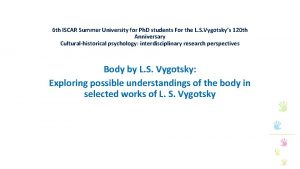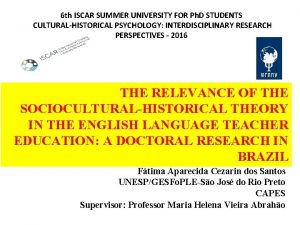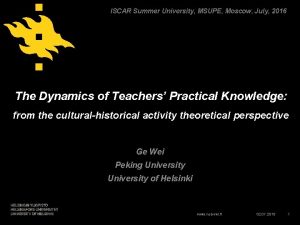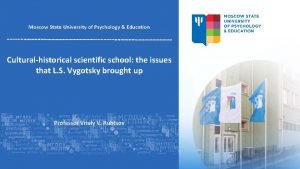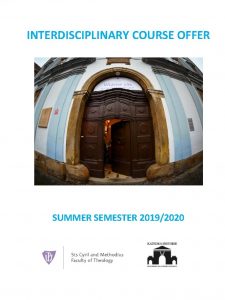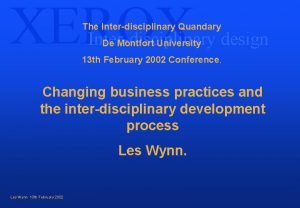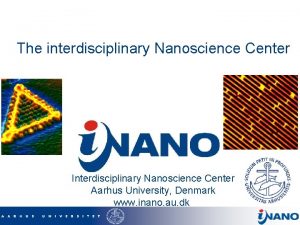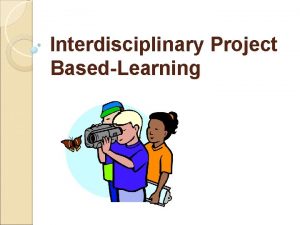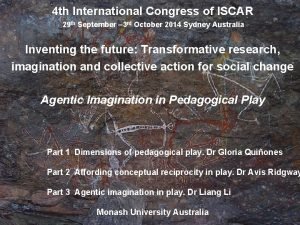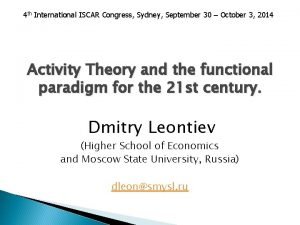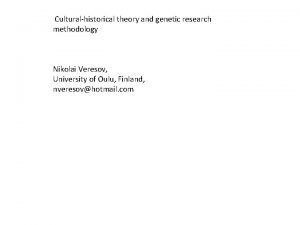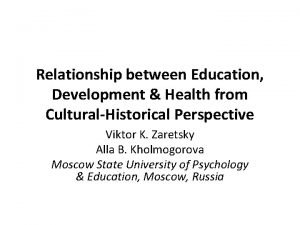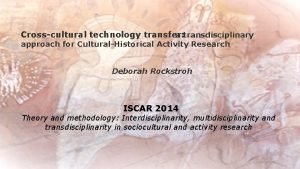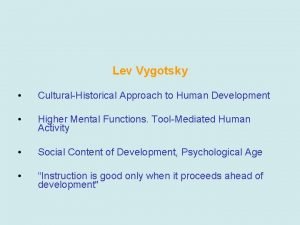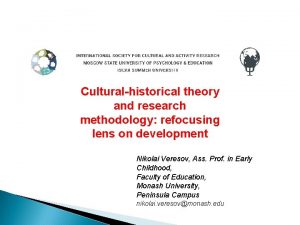6 th ISCAR Summer University Culturalhistorical psychology interdisciplinary































- Slides: 31

6 th ISCAR Summer University “Cultural-historical psychology: interdisciplinary research perspectives” Moscow, 28 June – 3 July 2016 The Approach of Concepts & Phenomena from Natural Sciences in the Framework of Cultural- Historical Theory: Clouds in Preschoolers Thought Glykeria Fragkiadaki Department of Educational Science & Early Childhood Education University of Patras, Greece gfragkiadaki@upatras. gr Research Supervisor: Prof. Konstantinos Ravanis

Research Topic The substantial challenges that Cultural- Historical Theory can pose in Early Childhood Science Education Research • at a theoretical level • at a methodological level

The Early Childhood Science Education Research Over the last tree decades, • a distinct research field • substantial empirical studies on • how young children’s, aged 4 to 6 years old, approach concepts & phenomena from the natural world • how they develop scientific thinking & understanding • the corresponding educational practices in kindergarten

The Early Childhood Science Education Research Three basic models of research approaches Based on discrete theoretical traditions of children’s learning & development • approaches based on e m p i r i c i s t i d e a s (Conezio & French, 2002) • approaches arising from the p i a g e t i a n p a r a d i g m (Ravanis, 1994) • approaches combining both post- piagetian & vygotskian views of learning in a s o c i o - c o g n i t i v e perspective (Ravanis & Bagakis, 1998)

The Early Childhood Science Education Research However, Little attention on • a conceptualization of child as a whole • a holistic view of child’ s development • bringing together diverse aspects • highlighting the interrelations • designate complexity & uniqueness of child’s thought

Is that a problem for Early Childhood Science Education Research? A contemporary crisis projected in the field • important results are disregarded • a round about procedure • a gap between research & educational reality Ä How can we minimize these contradictions in Early Childhood Science Education Research?

Drawing upon Cultural Historical Theory… Why Vygotsky? A dialectical approach Interrelations: personal characteristics & social, cultural & material context/ emotionsactions & consciousness U nits of analysis: multi variables, multiple options of the same psychological/ social activity or situation U nity : psychological phenomena in their entirety/ the hole process (Dafermos, 2015 a, 2015 b; Veresov, 2016; Vygotsky , 1989, 1994, 1998 )

The Paradigm A new research tradition • re - organizing the classic research procedures & recording alternative types of results • new directions & foundations are laid towards this research orientation to the study of young children in Science Education • (O’ Loughlin, 1992; Lemke, 2001; Fleer, 2002, 2011; Fleer et al. , 2014; Fleer & Robbins, 2003; Hedegaard & Fleer, 2008; Robbins, 2005; Larsson, 2013; Tu, 2006)

Research Motivation A methodological shifting • a linear approach • a systemic approach • concrete elements/ functions • study of procedures/ systems • static circumstances • flexibility • autonomous areas • contextual understanding • isolated incidents • every day reality • research objects • real life phenomena • generalization • individual development • educator as external factor • educator as a “cultural tool”

Research Aim To understand how preschool children experience science & develop scientific thinking as they interact with the social, cultural & material world • beyond learning dimensions • through a systemic view • towards specific aspects of the process of development

Research Questions Q 1: Which are the dialectical relations between the personal characteristics & the situational characteristics that appear in a collective science experience in kindergarten? Q 2: How are children experiencing their science activity? Q 3: How are children experiencing their science activity across various social situations?

Research Design Using a developmental research methodology, according to the experimental genetic method… ü Embryonic stage of the function ü Interaction of real & ideal form ü Developmental tools ü Qualitative changes ü Category (Veresov, 2010, 2014; Vygotsky, 1997)

Research Design A collective science experience in kindergarten Approach of clouds Phase 1 nature Phase 2 • formation • movement • correlations with every Phase 3 day activity • Combinations one child & the educator a pair of children, in different combination, & the educator a four children team & the educator

Data Collection • a professional development program of an educators’ network in Greece • basic concepts & principles of C- H Approach • initial sample 101 children => case studies (criteria: dramatic events & development) • video- recorded conversations • field notes & drawings • NVivo qualitative data analysis software

Analytical Tools Concept Perezhivanie Historicity Precursor Models Method of analysis • child & environment as a unity • unity of intellect, affect & act developmental trajectories phases of scientific concept formation

Data analysis The case of D. R. : How can clouds come up from the rain (Κ. expressed earlier that explanatory scheme)? Have you ever thought about it? Κ. : No, you don’ t … D. : I have!! Κ. : Tell me! Tell me now… D. : Alright! I’ ll sign… I’ll sign you a song which is about clouds! R. : Yes… We would love to hear it… D. : (sings to the beat of a traditional counting-out game) Once upon a time… clouds came out amid the dust, the round dust. . . (gesturing her hands round). And sky comes out when it drizzle… When it drizzle then comes the rainbow, and when the rainbow comes here comes the cloud, too. . . (afterwards, they illustrate together the story)

Child’s Characteristics (Q 1 a) The case of D. Emerged Categories Data Examples Representations clouds as a round dust correlated with sky, rainbows (phenomenism) Sources a traditional counting-out game Experiences rotation of rain- good weather Abilities • • singing, gesturing, illustrating use of a model of alternations in nature

Environmental Characteristics (Q 1 b) The case of D. Basic Categories Emerged Categories Social Interactions • drama • collaboration • cooperation Material Interactions • use of drawing materials • a piece of wood to hold the rhythm

Q 1 c: Which are the dialectical relations? invitation for The Characteristics in a Unity, The case ofdevelopment D. R. : How can clouds come up from the rain (Κ. expressed earlier that explanatory scheme)? Have you ever thought about it? an Κ. : No (you don’ t) … drama: improvised D. : I have!! a collision song as a mean Κ. : Tell me! Tell me now… invitation for D. : Alright! I’ ll sing… I’ll sing you a song which is about clouds! development towards a R. : Yes… We would love to hear it… qualitative D. : (sings to the beat of a traditional counting-out game)change: sky, rainbow «Once upon a time… clouds came out amid the dust, the round dust. . . (gesturing her hands round). And sky comes out when it drizzle… When it drizzle then comes the rainbow, and when the rainbow collaboration comes here comes the cloud, too. . . as“ cooperation illustration (illustration) a mean the story)(song) (afterwards they illustrate together

Child’s Characteristics (Q 1) The case of D. Drawing

Q 2: How do children experience their science activity? The case of D. Basic Categories Emerged Categories Intellect thinking, understanding, awareness, imagination, creativity Affect attitude, intentions, expectations, emotional state, memories, will Act regulations, gestures, body movement Chen, 2015

Q 2: How do children experience their science activity? The case of D. R. : How can clouds come up from the rain (Κ. expressed earlier that intention & you ever thought about it? explanatory scheme)? Have will to struggle Κ. : No, you don’ with t … the idea D. : I have!! thinking about how to come Κ. : Tell me! Tell me now… closer to an D. : Alright! I’ ll sing… I’ll explanation sing you a song which is about clouds! imagination, R. : Yes… We would love to hear it… creativity & concept D. : (sings to the beat of a traditional counting-out game) formation Once upon a time… clouds came out amid the dust, the round dust. . . thinking about (gesturing her hands round). And sky comes out when it drizzle… how rainbow to When it drizzle then comesgestures the rainbow, and when the & combine the body comes here comes the cloud, too. . . (afterwards, they illustrate elements movement together the story)

Q 3: How do children experience their science activity across various phases? Developmental trajectory, The case of D. Qualitative changes towards a explanatory model more compatible with the scientific one Magical dust from gold jewelries in a box (explanatory scheme based on imagination) Dust correlated with sky & air as a moving force (explanatory scheme based on a phenomenism) Correlation with sky, rainbows (explanatory scheme based on natural causality)

Towards a new insight… • Classical methodologies are not one-way option in the field of Early Childhood Science Education Research • Drawing upon a d i a l e c t i c a l a p p r o a c h CHT • functional methodological models • a better understanding of the uniqueness & complexity of children's scientific thought • A re- conceptualization, a new theorization of Early Childhood Science Education

References Conezio, K. , & French, L. (2002). Science in the preschool classroom: Capitalizing on children's fascination with the everyday world to foster language and literacy development. Young Children, 57(5). 12 -18. Chen, F. (2015). Parents' perezhivanie supports children's development of emotion regulation: a holistic view. Early Child Development and Care, 185(6), 851 -867. Dafermos, M. (2015 a). Critical reflection on the reception of Vygotsky’s theory in the international academic communities. In B. Selau & R. Fonseca de Castro (Eds. ), Cultural-Historical Theory: Educational Research in Different Contexts (pp. 19 -38). Porto Alegre: EDIPUCRS. Dafermos, M. (2015 b). Reflection on the Relationship between Cultural-historical Theory and Dialectics. Психологическая наука и образование, 20(3). Fleer, M. , Gomes, J. , & March, S. (2014). Science learning affordances in preschool environments. Australasian Journal of Early Childhood (39)1, 38 -48. Fleer, Μ. , & Robbins, J. (2003). “Hit and Run Research” with “Hit and Miss Results in Early Childhood Science Education. Research in Science Education, 33, 405 - 431. Fleer, M. (2002). Sociocultural assessment in early childhood education- Myth or reality? International Journal of Early years Education, 10(2), 105 -120. Fleer, M. (2011). Kindergarten in Cognitive Times: Imagination as a Dialectical Relation between Play and Learning. International Journal of Childhood, 43(3), 245 - 259.

References Hedegaard, M. & Fleer, M. (2008). Studying children- A cultural historical approach. Glasgow: Open University Press. Larsson, J. (2013). Contextual and Conceptual Intersubjectivity and Opportunities for Emergent Science Knowledge. International Journal of Early Childhood, 45, 101 - 122. Lemeignan, G. & Weil-Barais, A. (1993). Construire des concepts en Physique. Paris: Hachette. Lemke, J. L. (2001). Articulation communities: Sociocultural perspectives on science education. Journal of Research in Science Teaching, 38(3), 296 - 316. O’ Loughlin, M. (1992). Rethinking science education: Beyond Piagetian constructivism toward a sociocultural model of teaching and learning. Journal of Research in Science Teaching, 29 (8), 291320. Ravanis, K. , & Bagakis, G. (1998). Science Education in kindergarten: sociocognitive perspective. International Journal of Early Years Education, 6(3), 315 -327. Ravanis, K. (1994). The discovery of elementary magnetic properties in pre-school age. A qualitative and quantitative research within a piagetian framework. European Early Childhood Education Research Journal, 2(2), 79 -91. Robbins, J. (2005). “Brown packages”? A sociocultural Perspective on Young Children’s Ideas in Science. Research in Science Education, 35, 151 - 172.

References Tu, T. (2006). Preschool science environment: What is available in a preschool classroom? Early Childhood Education Journal, 33(4), 245– 251. Veresov, N. (2010). Introducing cultural historical theory: main concepts and principles of genetic research methodology. Cultural-Historical Psychology, 4, 83 -90. Veresov, N. (2014). Refocusing the Lens on Development: Towards Genetic Research Methodology. In M. Fleer & A. Ridgway (Eds. ). Visual Methodologies and Digital Tools for Researching with Young Children. Springer, pp. 129 -149. Veresov, N. (2016). Duality of categories or dialectical concepts? . Integrative Psychological and Behavioral Science, 50(2), 244 -256. Vygotsky, L. S. (1989). Concrete human psychology. Soviet Psychology, 27(2), 53– 77. Vygotsky, L. S. (1994). The problem of environment. In R. V. D. Veer & J. Valsiner (Eds. ), The Vygotsky reader. Oxford: Blackwell. Vygotsky, L. S. (1997). Collected Works of L. S. Vygotsky (Vol. 4, The History of the Development of Higher Mental Functions). Vygotsky, L. S. (1998). The collected works (Vol. 5). New York: Plenum.

Thank you for your attention Glykeria Fragkiadaki Department of Educational Science & Early Childhood Education University of Patras, Greece gfragkiadaki@upatras. gr

Research Questions Method of Analysis Analytical Tool/ Unit of Analysis child’s characteristics Representations Q 1 b c Q 2 Q 3 Which are the situational characteristics that can appear in a collective science experience in kindergarten? Aspect 1: Identification, description & interpretation of the interrelations between child & environment How do children experience their science activity across various phases? Sources Experiences Abilities environmental characteristics Social interactions Material interactions the characteristics in a unity Processes Types New structures Which are the dialectical relations between these characteristics that lead to qualitative changes in children’s thought? How do children experience their science activity? Aspect 2: the “prism” that gives the child’ s aspect Perezhivanie Which are the personal characteristics that a preschool child can bring to a collective science experience in kindergarten? intellect- affect- act in a dual independence Scientific Thinking Emotions Actions The Developmental developmenta trajectories l perspective Phase a, b, c Historicity a Data All the individuals All the phases Couples Teams Phase b, c All the individuals All the phases

The theoretical concept of “perezhivanie” perezhivanie social environment personal characteristics material environment (Adams & March, 2014)

Precursor Models • educational constructions designed to help students access the scientific models • include a number of characteristic elements of the scientific models • precursors to individual cognitive development (ontogenesis) & not in a historical perspective (ylogenesis) (Lemeigman et Weil-Barais, 1993)
 Pygmalion george bernard shaw
Pygmalion george bernard shaw One act iscar wilde play
One act iscar wilde play Iscar conference
Iscar conference A science is considered interdisciplinary when weegy
A science is considered interdisciplinary when weegy Multidisciplinary vs interdisciplinary
Multidisciplinary vs interdisciplinary What is interdisciplinary
What is interdisciplinary Single point lesson
Single point lesson Interdisciplinary notes
Interdisciplinary notes Interdisciplinary thematic units
Interdisciplinary thematic units Interdisciplinary understanding
Interdisciplinary understanding Interdisciplinary studies ucf
Interdisciplinary studies ucf Interdisciplinary engineering tamu
Interdisciplinary engineering tamu Is oceanography and interdisciplinary science?
Is oceanography and interdisciplinary science? Interdisciplinary lenses
Interdisciplinary lenses Carnegie mellon interdisciplinary
Carnegie mellon interdisciplinary Data science interdisciplinary
Data science interdisciplinary Evans center for interdisciplinary biomedical research
Evans center for interdisciplinary biomedical research Interdisciplinary approach to problem solving
Interdisciplinary approach to problem solving What is linguistics
What is linguistics Interdisciplinary math lesson plans
Interdisciplinary math lesson plans Zeigler 1990 interdisciplinary
Zeigler 1990 interdisciplinary Interdisciplinary multidisciplinary transdisciplinary
Interdisciplinary multidisciplinary transdisciplinary Tragedy of the commons
Tragedy of the commons Global carbon project
Global carbon project Interdisciplinary approach to climate change
Interdisciplinary approach to climate change Fluid intelligence examples
Fluid intelligence examples Haifa international school
Haifa international school кpi
кpi Fordham summer session 1
Fordham summer session 1 Sungkyunkwan university summer school
Sungkyunkwan university summer school Boston university summer challenge
Boston university summer challenge Imperial university summer school
Imperial university summer school


